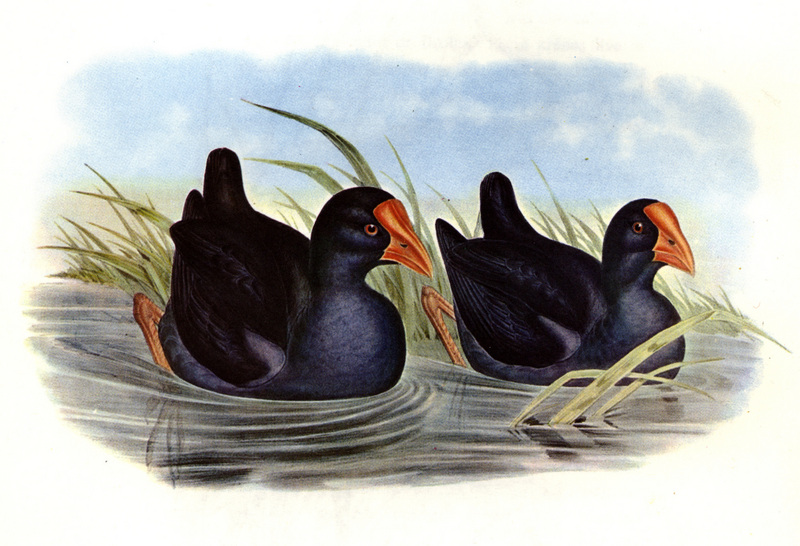|
| 질의: Tropical fish | 결과: 534번째/760 | |
Purple Swamphen (Porphyrio porphyrio) - Wiki
| 제목: | Purple Swamphen (Porphyrio porphyrio) - Wiki
| |

| 해상도: 2000x1364
파일크기: 1126504 Bytes
촬영일: 2006:07:14 15:24:43
사진기:
등록시간: 2007:01:24 01:38:30
|
Purple Swamphen
From Wikipedia, the free encyclopedia
[Photo] Swamp hen. Source: Birds of Australia. Date: 1865. Author: John Gould
The Purple Swamphen (Porphyrio porphyrio), formerly also known as the Purple Gallinule, is a large bird in the family Rallidae. From its name in French, tal??ve sultane it is also sometimes known as the Sultana Bird. It should not be confused with the American Purple Gallinule, Porphyrio martinica. A New Zealander M??ori name for the subspecies P. p. melanotus is p??keko.
Taxonomy and physical description
There are six or more subspecies of the Purple Swamphen, depending on the authority, which differ mainly in the plumage colours. The races are:
P. p. porphyrio in Europe
P. p. madagascariensis in Africa
P. p. poliocephalus in tropical Asia
P. p. melanotus in much of Australasia
P. p. indicus in Indonesia
P. p. pulverulentis in the Philippines.
European birds are overall purple-blue, African and south Asian birds have a green back, and Australasian and Indonesian birds have black backs and heads. The Philippines subspecies is pale blue with a brown back. This chicken-sized bird, with its huge feet, bright plumage and red bill and frontal shield is unmistakable in its native range.
Purple Swamphens are considered to be the ancestors of several island species including the extinct Lord Howe Swamphen and two species of Takah?? in New Zealand. The Purple Swamphen itself, deriving from a later self-introduction, is a native of New Zealand, where it is called the P??keko. Its range is thought to have expanded there after the arrival of humans as the numbers of Takah?? declined to near-extinction levels.
Reproduction
The breeding habitat is warm reedbeds across southernmost Europe, Africa, tropical Asia, and Australasia. Pairs nest in swamps, clumps of rushes in paddocks or long unkempt grass. Multiple females lay in the one nest and share the incubation duties, the nest is composed of grass or similar materials. Each bird can lay 3-6 speckled eggs and a communal nest may contain up to 12 eggs, incubation period is 24 days.
Ecology and behavior
The Purple Swamphen prefers wet areas with high rainfall, swamps, lake edges and damp pastures. The birds often live in pairs and larger communities. It clambers through the reeds, eating the tender shoots and vegetable-like matter, they have been known to feed on invertebrates (like snails) and to rob eggs from nests. Sometimes they eat small fishes as well. They will often use one foot to bring food to their mouth rather than eat it on the ground. Where they are not persecuted they can become tame and be readily seen in towns and cities.
This species has a very loud explosive call, also described as a "Raucous high-pitched screech, with a subdued musical 'tuk-tuk'". In spite of being clumsy in flight it can fly long distances, it is also a good swimmer (Especially for a bird without webbed feet).
Roman times
Evidence from Pliny the Elder and other sources shows that the Romans kept Purple Swamphens as decorative birds at large villas and expensive houses. They were regarded as noble birds and were the only birds that Romans did not eat.
Escapes and introductions
Purple Swamphen is occasionally recorded as an escape from captivity in Britain and elsewhere. An introduced population exists in Florida. See Purple Swamphens in North America.
http://en.wikipedia.org/wiki/Purple_Swamphen
| The text in this page is based on the copyrighted Wikipedia article shown in above URL. It is used under the GNU Free Documentation License. You may redistribute it, verbatim or modified, providing that you comply with the terms of the GFDL. |
|
^o^
동물그림창고 똑똑전화 누리집
^o^
|
|